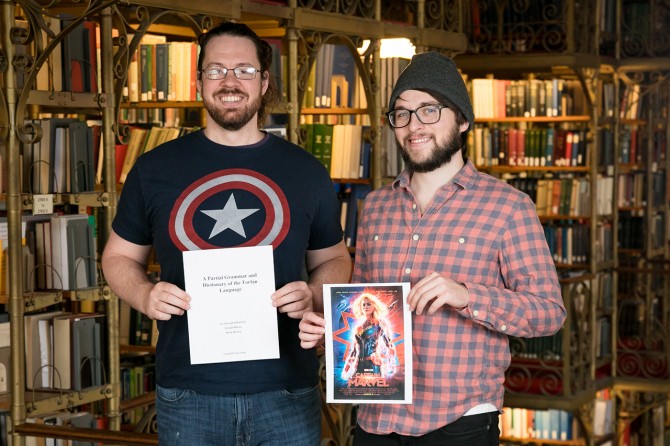In order to bring Marvel’s newest Avenger to the big screen, the producers of “Captain Marvel” contacted linguistics professor Michael Weiss with a task: Develop an alien language for the people of Torfa to be used in a scene that was to be shot in one week. Weiss gave the Herculean job to his Ph.D. students Ryan Hearn and Joseph Rhyne and they responded like heroes.
Linguistics students create language for ‘Captain Marvel’
By Catherine Gorey
Marvel Cinematic Universe’s “Captain Marvel,” released in March, features the work of Cornell linguistics doctoral students Ryan Hearn and Joseph Rhyne. They created the alien language Torfan, which is used in the film.
Torfan is loosely based on Japanese but with a different sound system. Linguistics researchers, Hearn said, are used quite regularly in large-scale science fiction works.
“Any time you have to create a new language, you can either just put together a bunch of sounds or go about creating a new language,” he said. “To do the latter, you need to know what things you can change to make it sound like a human or alien language. That comes from a linguistic background.”
Marvel – whose latest film, “Avengers: Endgame,” will be released April 26 – routinely creates new, complex languages for its movies. An online fan page for the enterprise lists over 300 alien races with distinct cultures and histories.
Hearn and Rhyne, who both focus on historical linguistics, are advised by linguistics professor Michael Weiss, who was contacted by Marvel Studios about the project and passed it on to them.
When attempting to create a new language, Hearn and Rhyne had to tackle multiple issues – from understanding the director’s vision for the film, to making the language sounds consistent, to ensuring that the language reflected the culture of the group of characters in the film.
“The most important thing is you want the language to reflect the culture because you can’t divorce the two,” Hearn said. “Once you decide what aspects of the culture you want to represent in the language, then you start working on the phonology, the sound system, and how that language’s form works, the morphology. You also think about how that language puts words together to form sentences, the syntax.”
All of these aspects fit together to create a language that “stays true to the artistic vision,” Hearn said.
Rhyne worked specifically on the creation of individual words, in order to maintain a consistent sound and feel.
Their final product consisted of a manual of grammar rules, a list of sounds within the language, notes about what happens when certain sounds are next to each other, a breakdown of the syntax and word order, a short dictionary of 300 words, and audio recordings of dialogue.
Hearn and Rhyne said the hardest part of the process was communication with the studio and the timeline of production. “The movie was proceeding so fast in regards to filming, so sometimes the turnaround would be on a short time span,” Hearn said. “There were a lot of late nights needed to meet deadlines.”
The two said the late hours and stress were worth it, though, when they saw their names listed in the credits.
Rhyne is also proud of working on a film that fosters diversity and inclusion in the science fiction genre. The film’s main character is Carol Danvers (Captain Marvel), played by Brie Larsen, making it the first female-led move in the Marvel Cinematic Universe; it was co-directed by Anna Boden, the first woman to direct a Marvel movie.
“Having it be the first female hero to get their own movie in the Marvel Universe is really cool,” he said. “Being part of a film that expands the realm beyond straight white male heroes is something that I’m really proud to be a part of.”
Catherine Gorey is a communications assistant for the College of Arts and Sciences.
Media Contact
Get Cornell news delivered right to your inbox.
Subscribe

